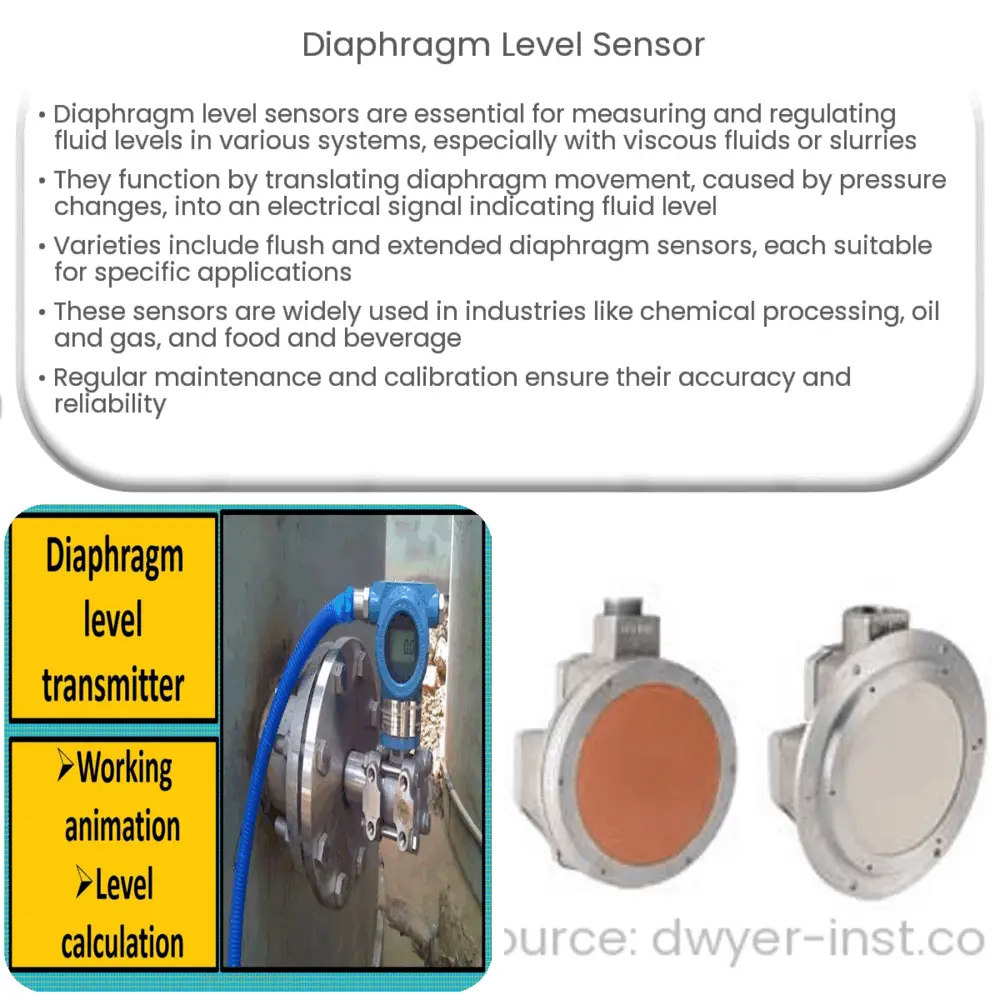Explore the workings, types, applications, and maintenance of diaphragm level sensors, a vital tool for accurate fluid level measurements in various industries.

Understanding Diaphragm Level Sensors
Diaphragm level sensors, also known as diaphragm pressure sensors, are critical components in numerous industrial applications. These devices play a fundamental role in measuring and regulating fluid levels in various containers and systems. They’re particularly effective when used for viscous fluids, slurries, or when media compatibility is an issue.
The functioning of a diaphragm level sensor is based on a simple yet effective principle. When pressure is applied to the sensor’s diaphragm, it moves. This movement is then translated into an electrical signal, which can be calibrated to correspond to the level of fluid in the container. But how is this accomplished? Let’s delve deeper.
Components and Working Principle
A diaphragm level sensor is typically composed of a sensing element, a diaphragm, and an electrical circuit. The sensing element, often a strain gauge, is attached to the diaphragm. The diaphragm itself is a flexible disk that deforms or ‘deflects’ under pressure.
When the fluid level changes in a container, it generates a change in pressure. This pressure difference is applied to the diaphragm, causing it to deflect. The degree of deflection is proportional to the fluid level. As the diaphragm moves, it alters the strain gauge’s resistance. The electrical circuit then converts this change into an electrical signal, which can be read by a level indicator or control system.
Types of Diaphragm Level Sensors
- Flush Diaphragm Pressure Sensors: These sensors are typically used when the measurement of viscous fluids or slurries is required. The diaphragm is designed to be flush with the surface of the process connection, preventing any material from accumulating and causing a measurement error.
- Extended Diaphragm Pressure Sensors: These sensors are often used in vessels or pipes where the fluid level needs to be measured from a specific reference point. The extended diaphragm allows for the measurement to be taken from the bottom of the vessel.
While the principle and components of diaphragm level sensors remain constant, their designs may vary based on the specific needs of an application. Understanding these variations allows for more accurate and effective use of these essential devices in various industries.
Applications of Diaphragm Level Sensors
Diaphragm level sensors are utilized across a broad range of industries, thanks to their versatility and robustness. Their ability to accurately measure fluid levels in challenging conditions makes them indispensable for many industrial applications.
- Chemical Industry: These sensors are employed in chemical processing plants to maintain precise fluid levels in tanks and vessels, ensuring safety and efficiency. Given their resistance to corrosion and compatibility with various media, they are particularly suited for this environment.
- Oil and Gas: In the oil and gas sector, diaphragm level sensors are used in offshore drilling rigs, refineries, and pipelines. They play a crucial role in controlling the levels of oil, gas, and other fluids to prevent overflows and maintain operational efficiency.
- Food and Beverage: In the food and beverage industry, these sensors are used to monitor levels in brewing vats, storage tanks, and pipelines. They help ensure consistent product quality by maintaining exact levels during production processes.
Maintenance and Calibration
Like any other industrial device, diaphragm level sensors require routine maintenance and calibration to ensure they perform accurately and reliably. Over time, the diaphragm may undergo wear and tear, which can affect its responsiveness to pressure changes. Regular checks and necessary repairs can help maintain the sensor’s performance and longevity.
Calibration is also crucial. It involves adjusting the sensor’s output to match a known input, ensuring the device accurately reflects the fluid level. It’s typically recommended that diaphragm level sensors are calibrated at least once a year, though the frequency may vary depending on the application and operating conditions.
Conclusion
In conclusion, diaphragm level sensors are a vital tool in many industries, enabling accurate and reliable fluid level measurements. Their design allows them to function in a variety of environments and with various types of fluids, making them incredibly versatile. By understanding how these sensors work and how to maintain them, users can ensure their operations run efficiently and safely. In a world where precision and reliability are key, diaphragm level sensors undeniably hold an important place.

